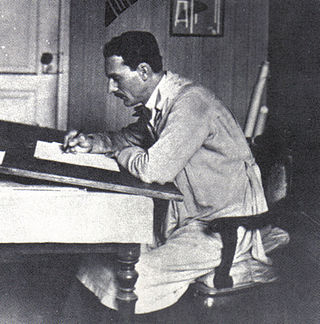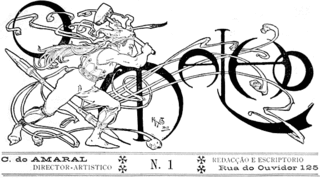Related Research Articles

Brazil, officially the Federative Republic of Brazil, is the largest country in South America and in Latin America. At 8.5 million square kilometers (3,300,000 sq mi) and with over 217 million people, Brazil is the world's fifth-largest country by area and the seventh most populous. Its capital is Brasília, and its most populous city is São Paulo. The federation is composed of the union of the 26 states and the Federal District. It is the only country in the Americas to have Portuguese as an official language. It is one of the most multicultural and ethnically diverse nations, due to over a century of mass immigration from around the world, and the most populous Roman Catholic-majority country.

Rio de Janeiro, or simply Rio, is the capital of the state of the same name, Brazil's third most populous state, and the second most populous city in Brazil, after São Paulo. Listed by the GaWC as a beta global city, Rio de Janeiro is the sixth most populous city in the Americas. Part of the city has been designated as a World Heritage Site, named "Rio de Janeiro: Carioca Landscapes between the Mountain and the Sea", on 1 July 2012 as a Cultural Landscape.

Samba, is a name or prefix used for several rhythmic variants, such as samba urbano carioca, samba de roda, recognized as part of the Intangible Cultural Heritage of Humanity by UNESCO, amongst many other forms of Samba, mostly originated in the Rio de Janeiro and Bahia States. Samba is a broad term for many of the rhythms that compose the better known Brazilian music genres that originated in the Afro-Brazilian communities of Bahia in the late 19th century and early 20th century, having continued its development on the communities of Rio de Janeiro in the early 20th century. Having its roots in the Afro-Brazilian Candomblé, as well as other Afro-Brazilian and Indigenous folk traditions, such as the traditional Samba de Caboclo, it is considered one of the most important cultural phenomena in Brazil and one of the country's symbols. Present in the Portuguese language at least since the 19th century, the word "samba" was originally used to designate a "popular dance". Over time, its meaning has been extended to a "batuque-like circle dance", a dance style, and also to a "music genre". This process of establishing itself as a musical genre began in the 1910s and it had its inaugural landmark in the song "Pelo Telefone", launched in 1917. Despite being identified by its creators, the public, and the Brazilian music industry as "samba", this pioneering style was much more connected from the rhythmic and instrumental point of view to maxixe than to samba itself.

Maria do Carmo Miranda da Cunha, known professionally as Carmen Miranda, was a Portuguese-born Brazilian singer, dancer and actress. Nicknamed "The Brazilian Bombshell", she was known for her signature fruit hat outfit that she wore in her American films. As a young woman, she designed hats in a boutique before making her first recordings with composer Josué de Barros in 1929. Miranda's 1930 recording of "Taí ", written by Joubert de Carvalho, catapulted her to stardom in Brazil as the foremost interpreter of samba.

José Carlos de Brito e Cunha, known as J. Carlos, was a Brazilian cartoonist, illustrator and graphic designer. J. Carlos also did sculpture, wrote vaudeville plays, wrote lyrics for samba and was a major talent in Brazilian Art Deco graphic design.
Chôros is the title of a series of compositions by the Brazilian composer Heitor Villa-Lobos, composed between 1920 and 1929.
Joel Zito Araújo is a Brazilian film director, writer and producer of films and TV programs. Since 1984, Araújo has produced one feature film, two short films and 25 documentaries. Some of these works have won prizes or been selected for screenings at film festivals throughout the world. From 2006 to 2007, Araújo was president of the Brazilian Filmmakers Association. He received his Ph.D. in Communication Sciences from the Escola de Comunicações e Artes at the University of São Paulo in 1999. He was Postdoctoral Fellow and Visiting Professor in the Departments of Radio, TV, and Film and Anthropology as well as the Center for African & African-American Studies at the University of Texas at Austin from August 2001 to May 2002.

Marcelo Caetano Moraes is a writer, professor and pianist from Brazil., critic, journalist.
The following is a timeline of the history of the city of Rio de Janeiro, Brazil.

Chôros No. 10 is a work for chorus and orchestra written in 1926 by the Brazilian composer Heitor Villa-Lobos. It is part of a series of fourteen numbered compositions collectively titled Chôros, ranging from solos for guitar and for piano up to works scored for soloist or chorus with orchestra or multiple orchestras, and in duration up to over an hour. Chôros No. 10 is of moderate length, one performance recorded by the composer lasting just under thirteen minutes.

Chôros No. 6 is an orchestral work written between 1925 and 1942 by the Brazilian composer Heitor Villa-Lobos. It is part of a series of fourteen numbered compositions collectively titled Chôros, ranging from solos for guitar and for piano up to works scored for soloist or chorus with orchestra or multiple orchestras, and in duration up to over an hour. Chôros No. 6 is one of the longer compositions in the series, lasting about 25 minutes in performance.

Chôros No. 4 is a quartet for three horns and trombone, written in 1926 by the Brazilian composer Heitor Villa-Lobos. It forms a part of a series of fourteen numbered compositions collectively titled Chôros, ranging from solos for guitar and for piano up to works scored for soloist or chorus with orchestra or multiple orchestras, and in duration up to over an hour. Chôros No. 4 is one of the shorter members of the series, a performance lasting about five-and-a-half minutes.

This is a timeline of Brazilian history, comprising important legal and territorial changes and political events in Brazil and its predecessor states. To read about the background to these events, see History of Brazil.
Problemas was a monthly political magazine published in Rio de Janeiro, Brazil. It was subtitled Revista Mensal de Cultura Política. The magazine was first published in August 1947. It was the official media outlet of the Brazilian Communist Party and was published by its central committee. Diogenes Arruda who was a member of the Communist Party's national secretary was the editor of the magazine. It included only translations of the articles from communist magazines without covering the events in Brazil. The magazine ceased publication in 1957.

O Malho was a Brazilian weekly satirical magazine published from 1902 to 1954. It was based in Rio de Janeiro, Brazil. It was the first commercially successful Brazilian satirical magazine during the Republican regime.
Senhor was a monthly cultural magazine published in the period of 1959 and 1964. The magazine was headquartered in Rio de Janeiro, Brazil.

Maria Beatriz do Nascimento, known as Beatriz Nascimento, was an Afro-Brazilian academic and activist. She was an influential participant of the Black Movement of Brazil from its beginnings in the 1960s until her death. Through her academic research, she evaluated the importance of quilombos as autonomous spaces for people of African descent during the colonial period and challenged the political environment and racial policies of the government toward Afro-Brazilians. Her scholarship on the invisibility of black women, and particularly non-Anglo women of the African diaspora had an international impact on research regarding the complexities of the black experience and lack of attention focused on Afro-Latinas in transnational feminism.

Francisco José do Nascimento, known as Dragão do Mar, was an Afro-Brazilian raft fisherman (jangadeiro), pilot and abolitionist figure, who in 1881 led a strike of his fellow jangadeiros in the port of Fortaleza, state of Ceará, refusing to transport enslaved black people to be sold in Rio de Janeiro and other Brazilian provinces.
Hanna Deinhard was a German-Brazilian-US art historian.

Everardo Pereira Guimarães Rocha is a Brazilian anthropologist dedicated to the study of consumption, advertising, and Brazilian culture. He earned his Ph.D. in Social Anthropology from the National Museum of Brazil at the Federal University of Rio de Janeiro in 1989. He is a Professor in the Department of Communication and its graduate program at the Pontifical Catholic University of Rio de Janeiro, where he has taught since 1976.
References
- 1 2 3 Cinearte, o cinema brasileiro em revista (1926-1942)
- ↑ "A revista Cinearte e o projeto de modernização cultural pelo cinema" (PDF). Archived from the original (PDF) on 2016-08-07. Retrieved 2016-07-06.
- 1 2 3 4 Stephanie Dennison; Lisa Shaw (November 27, 2004). Popular Cinema in Brazil: 1930-2001 . Manchester University Press. p. 45. ISBN 978-0-7190-6499-9 . Retrieved February 18, 2017.
- 1 2 Maite Conde (2012). Consuming Visions: Cinema, Writing, and Modernity in Rio de Janeiro. University of Virginia Press. p. 169. ISBN 978-0-8139-3214-9 . Retrieved February 18, 2017.